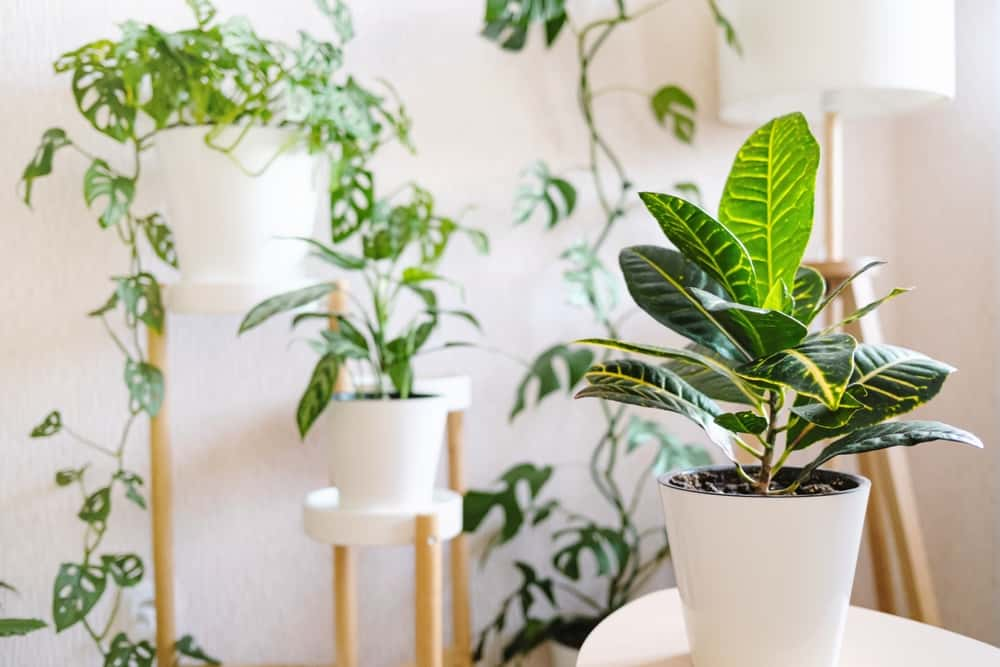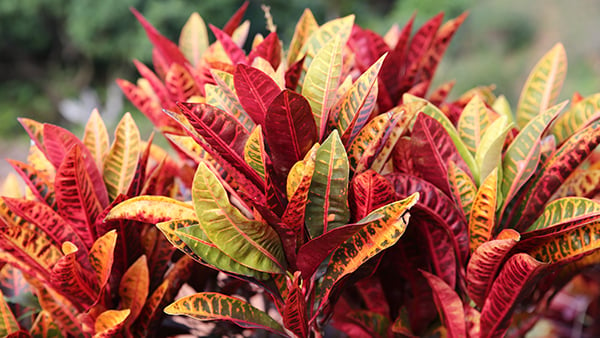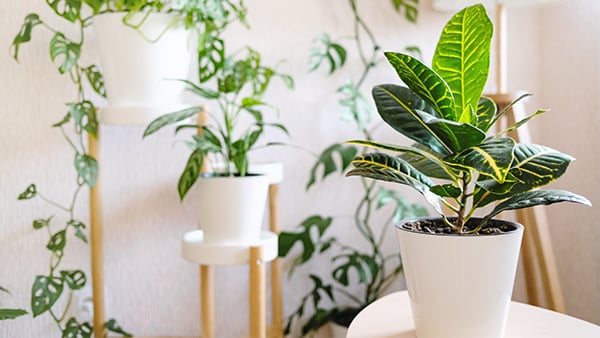Crotons are popular Indian house plants for their colourful foliage and intriguing patterns. They come in hundreds of varieties to be planted both indoors and outdoors. Mainly used for ornamental purposes, croton plants add a dash of colour and intrigue to your interiors, balcony, or vertical garden. Plus, the plants are low maintenance and ideal for beginners.
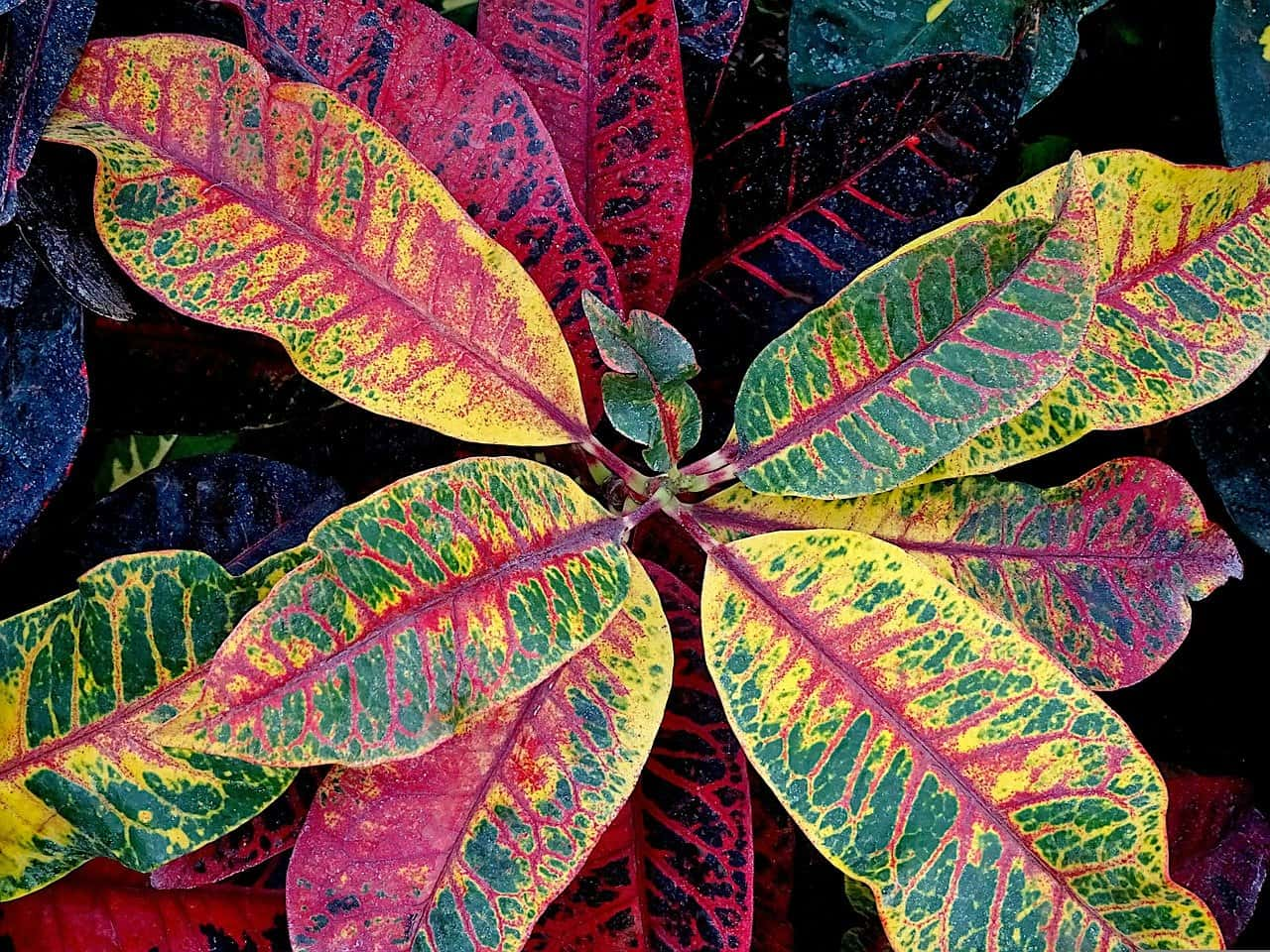
If you’re looking for the perfect croton plant for your home, we have a list of 12 different types of croton plants that can brighten up your living space. But before that, let’s learn more about our favourite houseplant.
About the Croton Plant
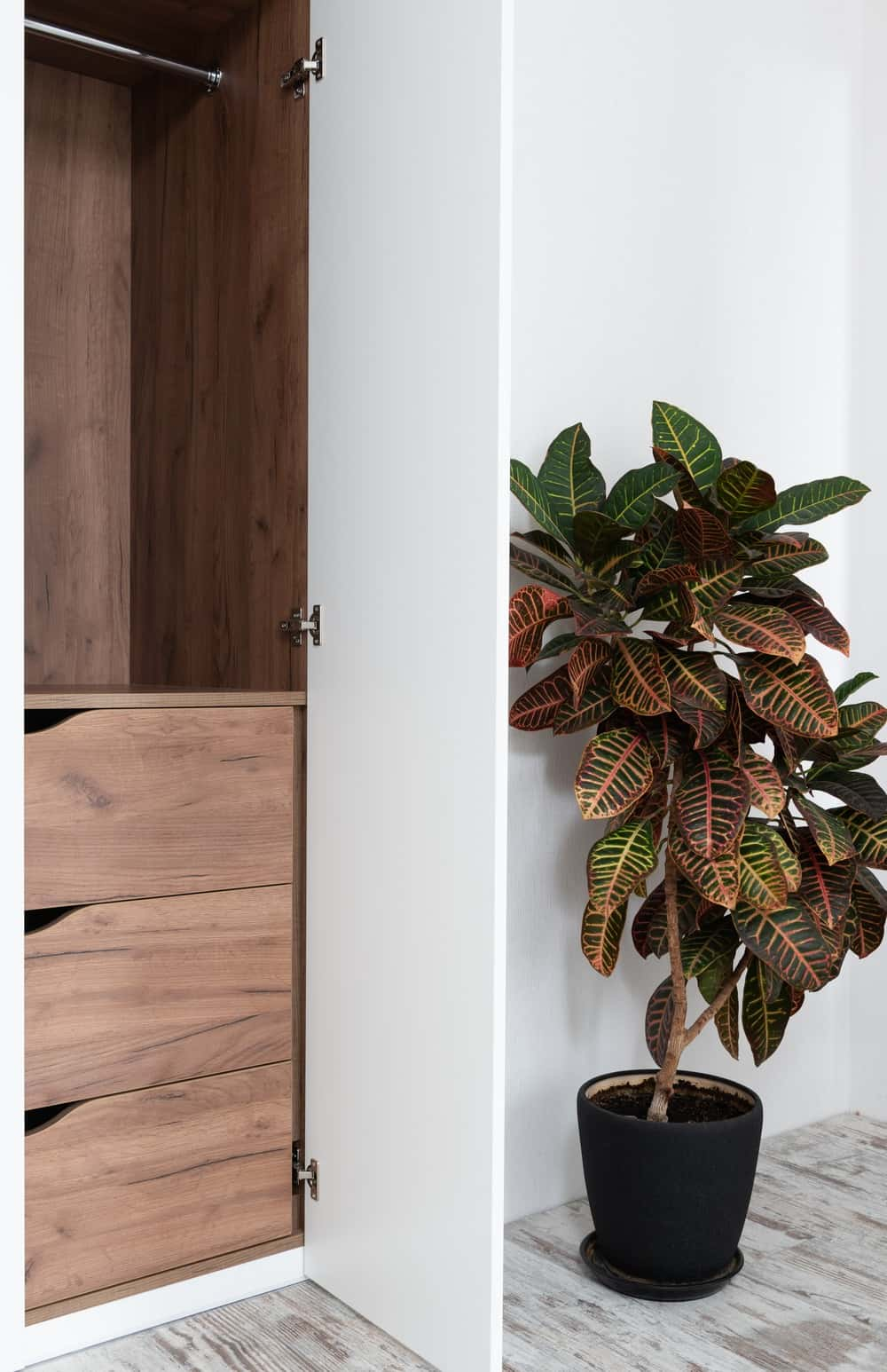
Croton plants hail from the spurge family, Euphorbiaceae, native to Indo-Malayan and Central American regions. The genus comprises various plants, including herbs, shrubs, and trees.
Croton plants are beloved houseplants, thanks to their bright, radiant foliage. The different types of crotons display a wide assortment of leaf shapes showcasing various colours spanning green, yellow, orange, pink, red, purple, and more. They are excellent air purifiers too!
However, most croton varieties are toxic if consumed. So better take necessary precautions to protect them from pets and children, especially if grown indoors.
Different Types of Croton Plants to Spruce Up Your Home
Finding the best plant that matches your interiors can be pretty challenging, considering the numerous types of croton plants available in India. So, to make your hunt easier, we’ve listed 12 popular croton plant varieties with pictures. Check them out!
1. Banana Croton
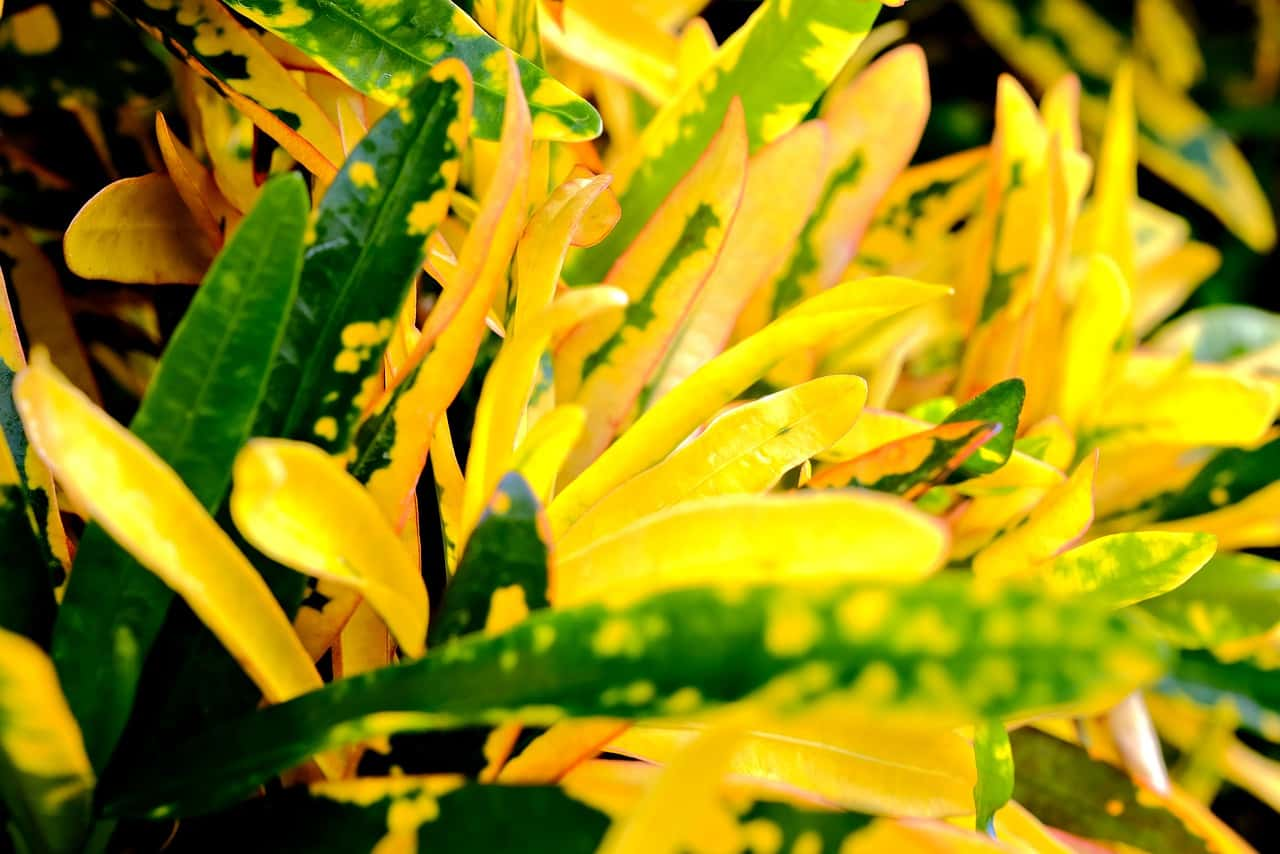
Add colour and life to your interiors with bright banana croton. This variety of croton is characterized by green oblong leaves spattered with patches of yellow. Usually a foot or two tall, the petit plant makes an excellent addition to bright interiors or sunny balconies.
2. Zanzibar Croton
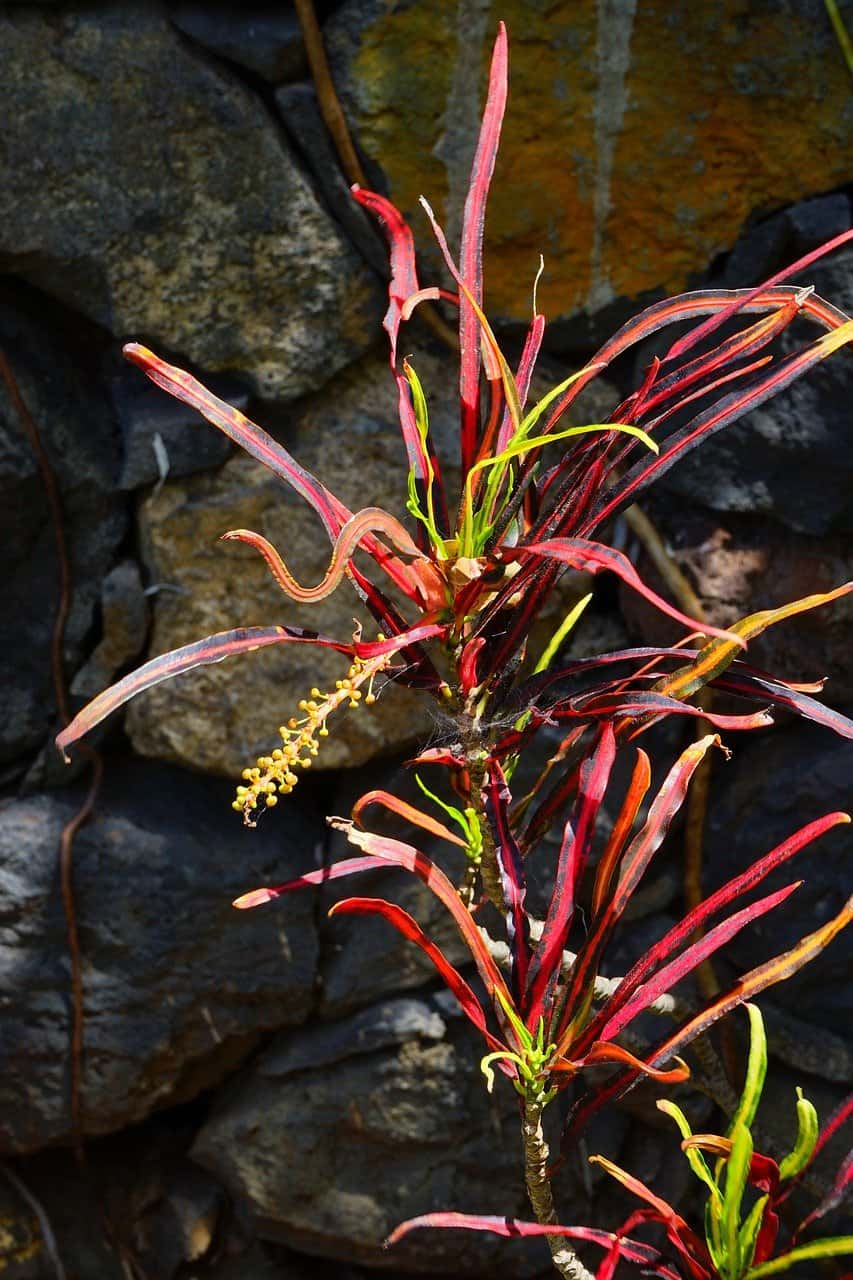
The long slender leaves of Zanzibar showcase beautiful shades of green, red, orange, yellow, and purple colours. This ornamental plant adds texture and contrast to any setting, ideal for decorating modern and contemporary home interiors. They usually grow three to four feet tall and thrive in bright lights.
This croton variety makes for one of the best indoor plants.
3. Magnificent Croton
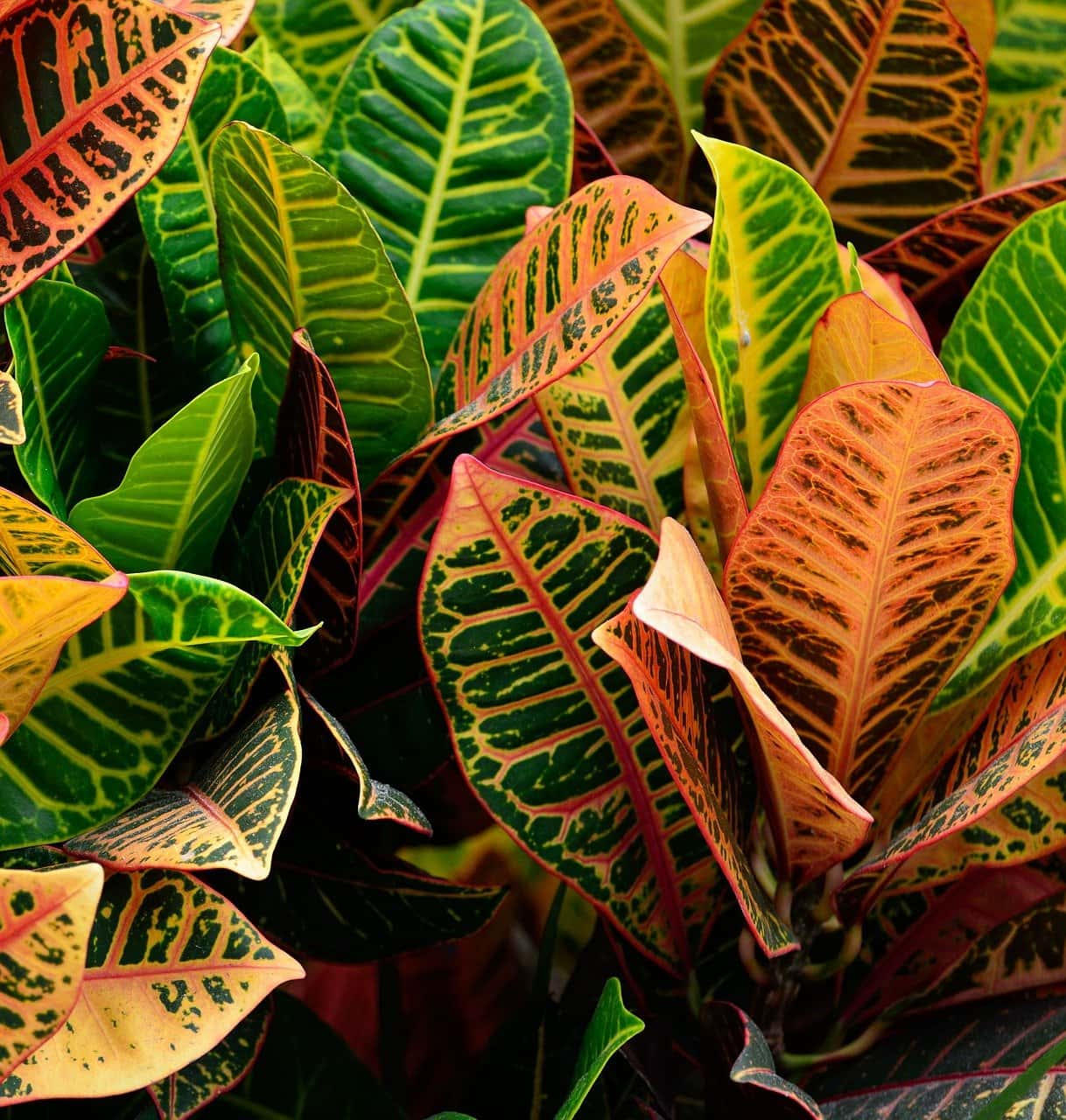
Soaked in the hues of the morning sun, magnificent croton plants are a delightful spectacle. The plant has large, broad leaves coloured in shades of green, pink, red, orange, burgundy, and deep purple.
Magnificient crotons can reach up to 7 feet in height when grown outdoors. They are resilient croton varieties that do not lose colour even in the shade. This makes them perfect for adding charm to the dull corners of your room.
4. Petra Croton
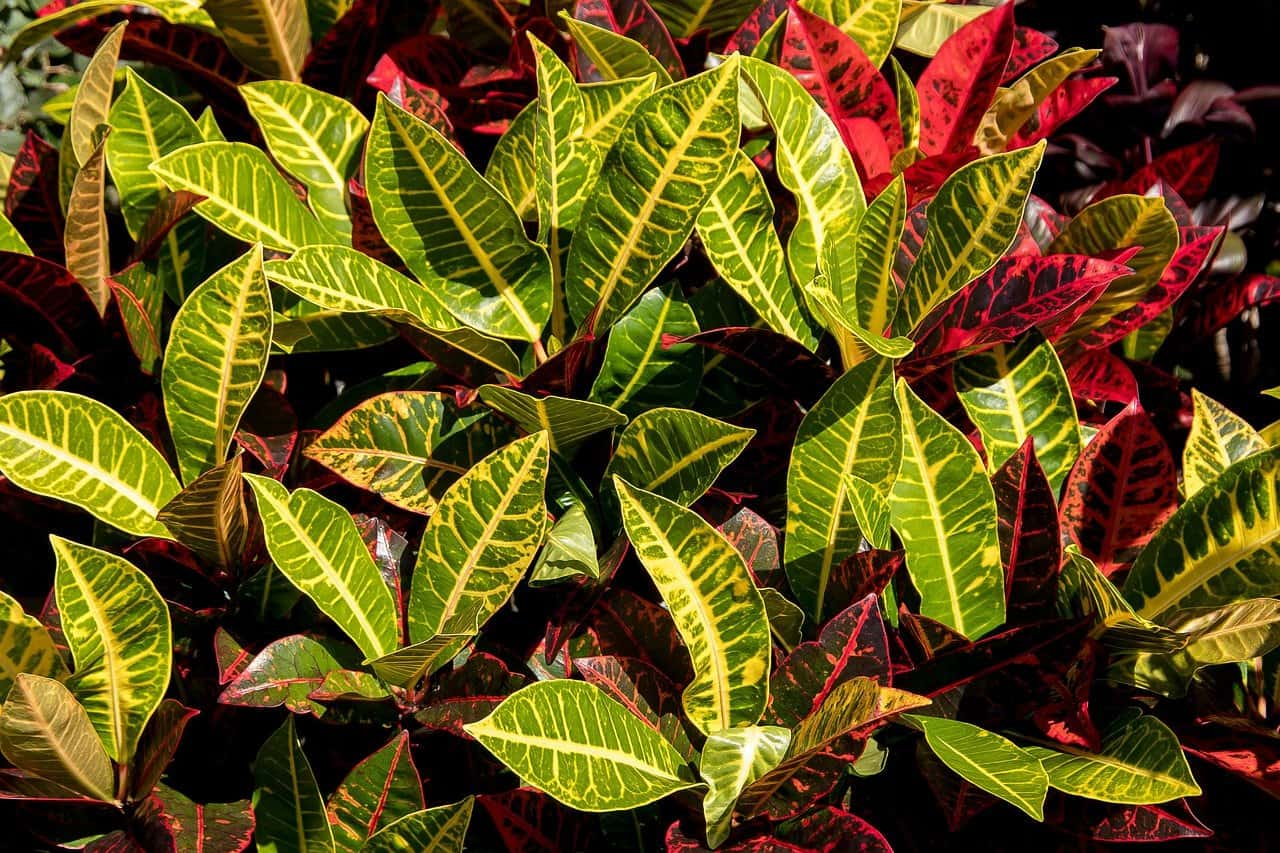 Petra Croton is another croton species native to Southeast Asia and South Pacific. The plant flaunts broad green leaves with yellow, red, or orange veins spreading throughout.
Petra Croton is another croton species native to Southeast Asia and South Pacific. The plant flaunts broad green leaves with yellow, red, or orange veins spreading throughout.
Petra croton is grown indoors in many areas. Depending on the container and the environment, the plant can grow up to six feet indoors.
Placing a large pot of Petra croton is one of the best balcony design ideas that never fails to impress.
5. Yellow Icetone Croton
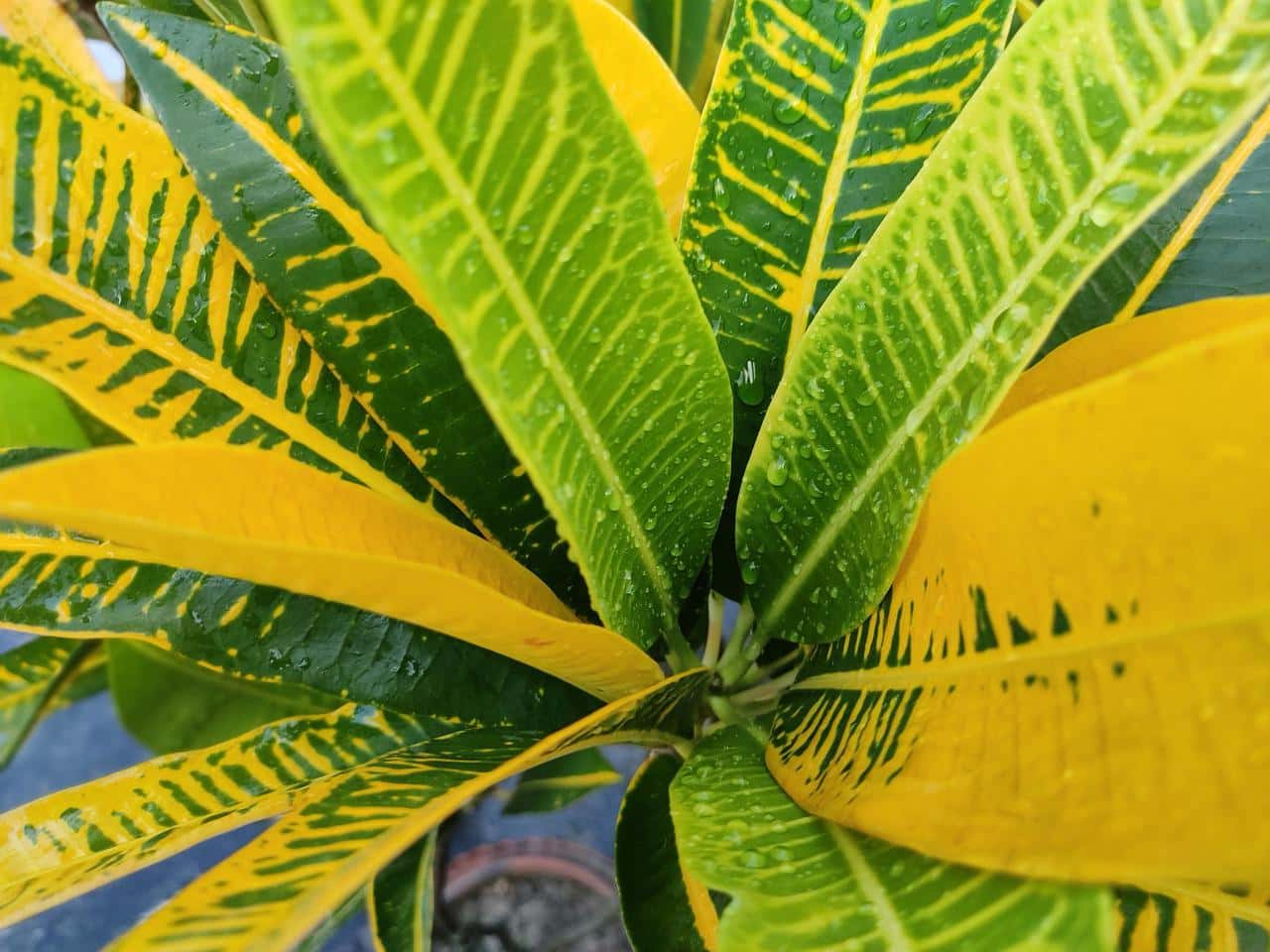
If you love yellow, you won’t be able to take your eyes off the warm Yellow Icetone. This bright house plant features pointed-tip oval leaves with light yellow variegation. The plant is believed to bring prosperity to its owner and is often given as a housewarming gift.
The warm Yellow Icetone croton can adorn both indoor and outdoor spaces. They grow up to three to four feet in height. Their flowers are rich in nectar and attract many butterflies and hummingbirds.
Alternatively, you can go for Red Iceton, which matures in striking shades of red and pink.
6. Mammy Croton
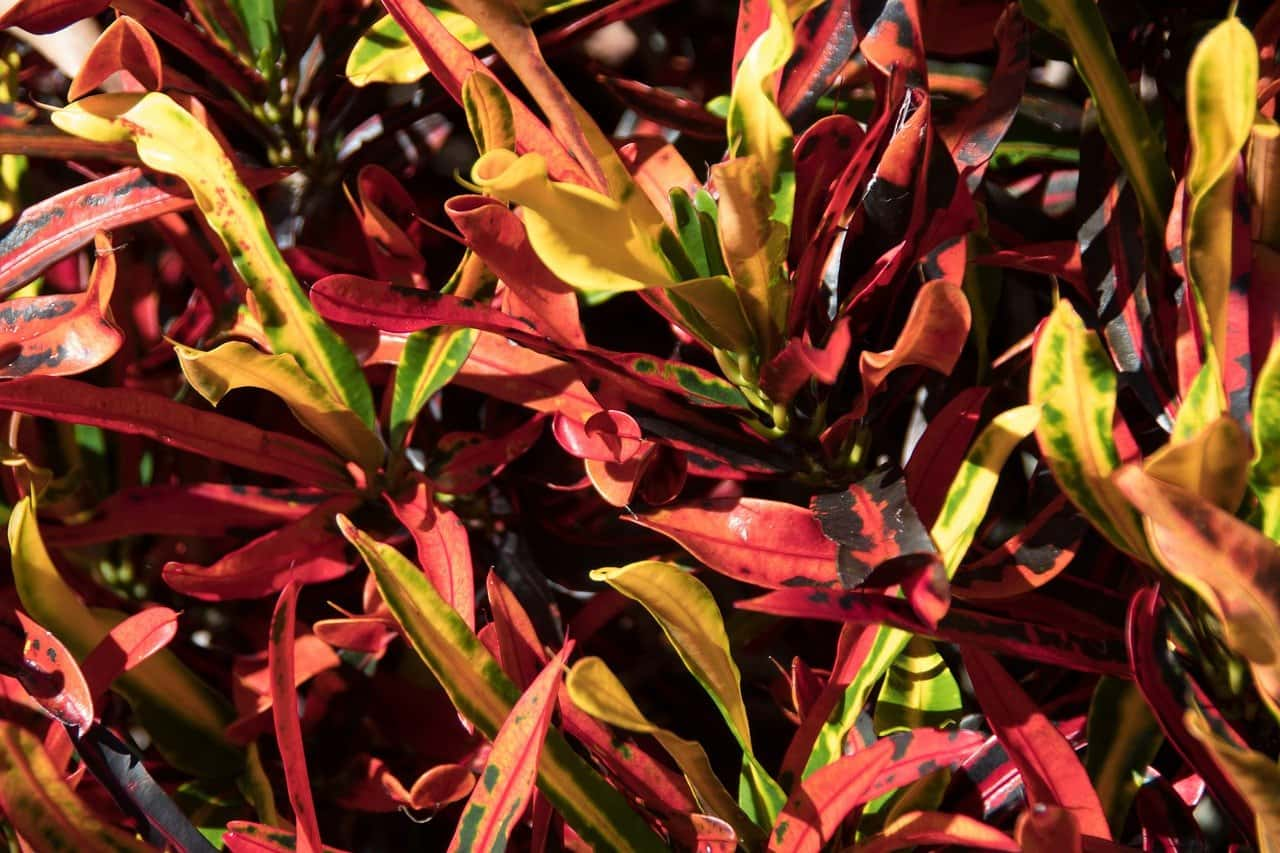
Bring your vertical garden ideas to life with mammy crotons. Mammy croton is perhaps the boldest and the most popular croton variety. It can be recognized by its colourful foliage and leaves that twist and curl upwards.
The plant’s glossy leaves and striking colour hold a high ornamental value that can pep up your balcony or living room. While the plant can be grown indoors and outdoors, it is better to take it in during cold seasons.
7. Gold Dust Croton
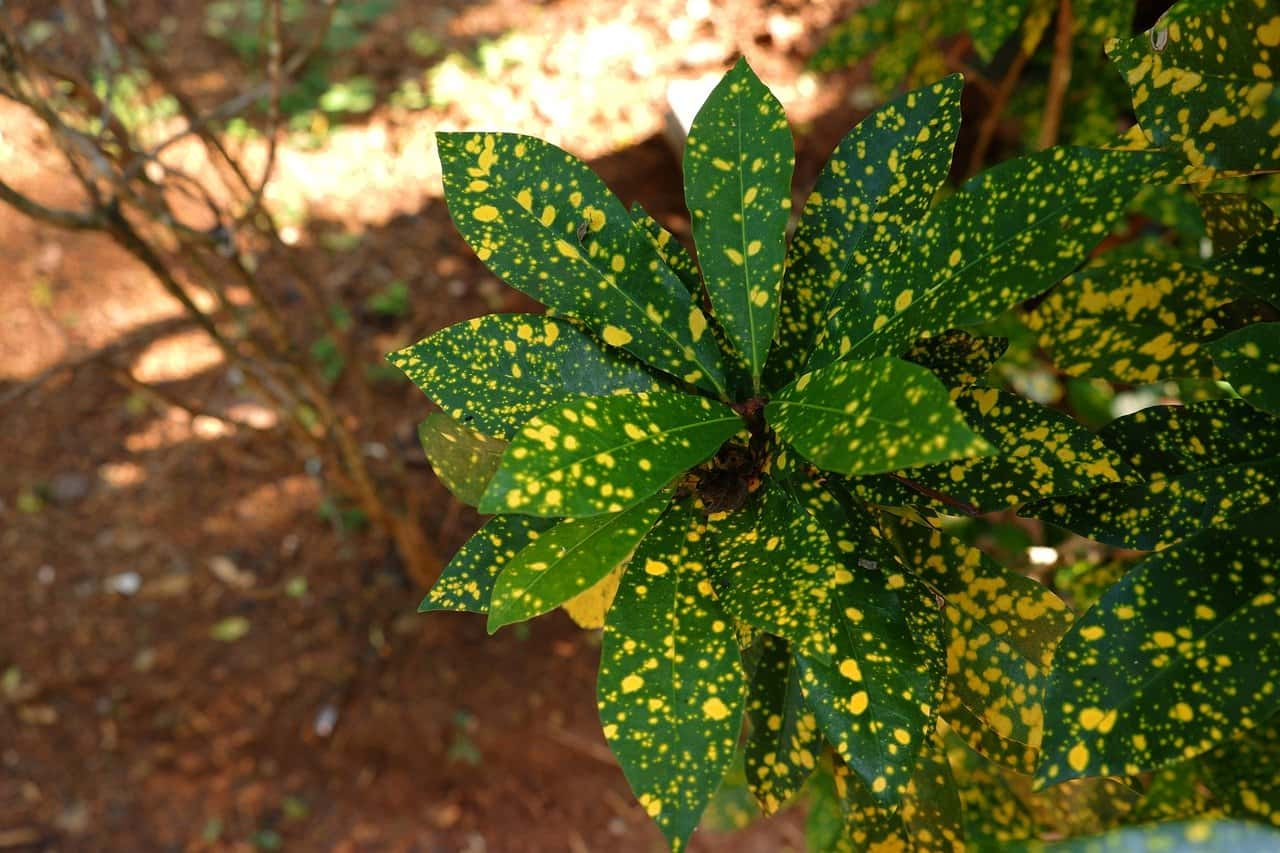
Gold dust croton is a popular croton plant variety with long thin green leaves dusted in spots of golden yellow. So you can see where the plant gets its name from.
Gold dust thrives best in humidity and places with indirect sunlight. So if you’re planning to keep it indoors, better place it where it can receive at least three to four hours of indirect light.
Easy to grow and pleasing to look at, gold dust is a variety that all plant lovers must have in their homes.
8. Andrew Croton

Andrew Croton is an uncommon variety of croton, thanks to its pointy leaves and creamy white hues. This Malaysian croton variety is better placed in shades to protect its leaves from bleaching. The leaves can reach up to 10 inches in length with proper care.
9. Bush on Fire
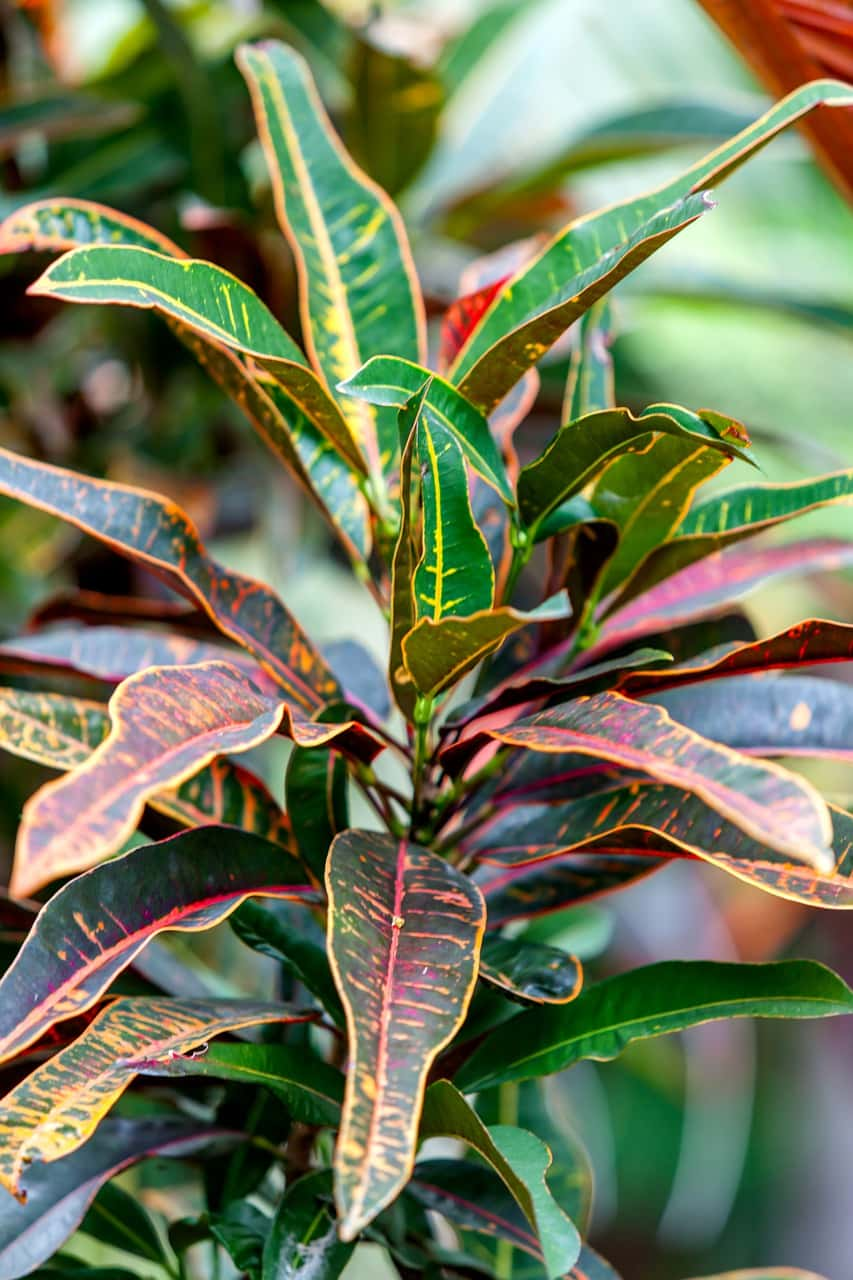
The bush on fire croton is named after its vibrant leaves splattered with yellow, pink, and red colours. The tropical plant is native to India, Sri Lanka, Malaysia, Indonesia, and the Western Pacific Ocean. Fun and quirky, they make a great addition to your indoor jungle.
Another notable feature of the plant is its frequent change of colours. A glance at this leafy beauty will brighten up your mood indoors.
10. Lauren’s Rainbow Croton
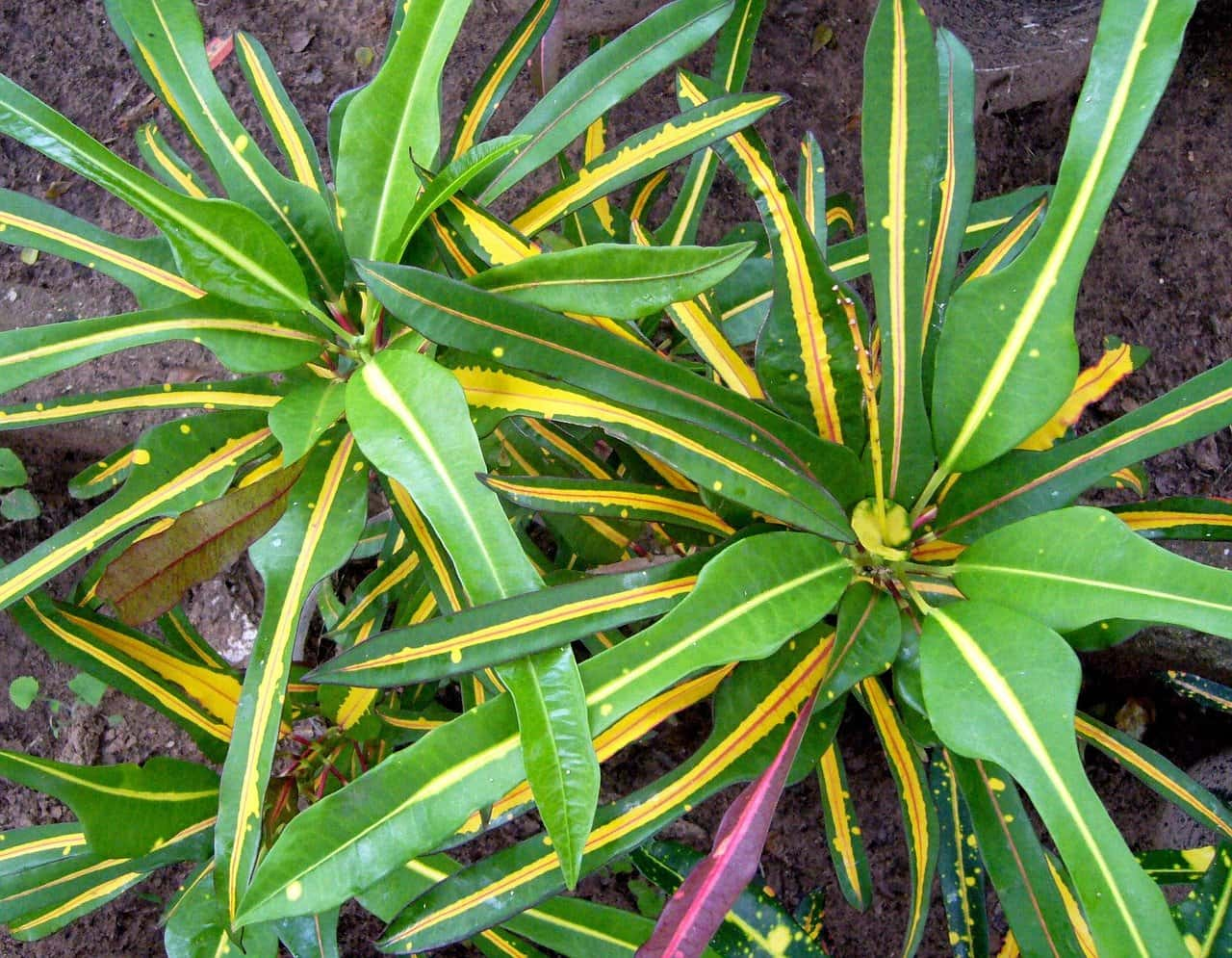
Lauren’s rainbow is an eye-catching croton variety featuring glossy oval leaves with striking shades of green, yellow, orange, bronze, and deep purple. Its bold colour and incredible texture lend high ornamental value that should be fully utilized.
Besides, its high drought tolerance and low humidity needs make the house plant an ideal choice for beginners.
11. Mother and Daughter Croton
Mother and daughter croton gets its name from its unmistakable leaf. The long narrow leaf gives the impression of holding another small leaflet at the end. It is a single leaf joined via the midrib.
The leaves of this croton vary from deep green to deep purple, with small yellow or ivory dashes spattered in between. This unique croton variety grows well in dappled sunlight. It can reach up to two feet indoors and four feet outdoors.
12. Picasso’s Paintbrush Croton
This croton type is as interesting as its name. The plant features slender leaves that resemble paintbrushes dipped in colourful pallets of bright colours. They resemble ornamental grass and add to your interiors alongside other croton varieties.
Croton Plant Care and Maintenance
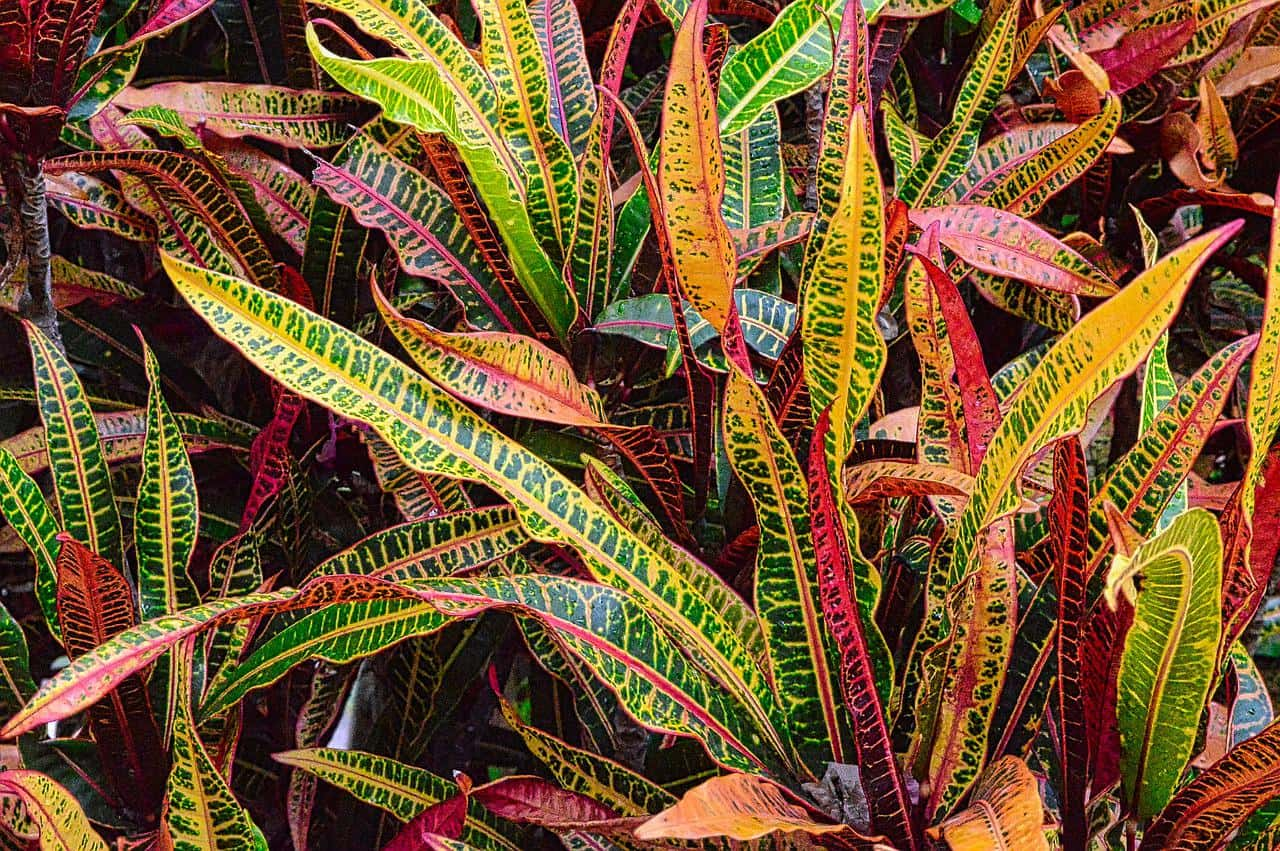
Croton plants are easy to care for and maintain. They thrive on sunlight and low humidity. So as long as you don’t overwater them, they will grow just fine.
Croton plants can be grown as outdoor plants in warmer climates. However, for other environmental conditions, they are best suited as a house plant. Croton plants can serve as beautiful accent pieces for your balcony, living room, or vertical garden when grown indoors.
The amount of sunlight croton leaves receive directly affects their colour. Plants exposed to brighter lights obtain a beautiful orange and red tint. On the other hand, plants placed in shades are greener in colour.
In case your plants lose their colour, place them in sunlight for some time until they get the vibrant shades back.
Other Ways of Classifying Croton Plants
The most common ways of classifying plants, at least to a layperson, would be by colour! And by far the most common varieties are red croton plants and green croton plants. We’ve listed below some of the most popular types of croton plants in these two colours so that you can make the right choices for your home décor.
Red Croton Plants
With their stunning foliage, red croton plants can add a fiery touch of the tropics to your home. The most popular red croton plant varieties include:
Bush on Fire Croton (Codiaeum variegatum ‘Bus on Fire’) This aptly named variety lives up to its fiery name with narrow, curled leaves in shades of red, orange, yellow and green. It is a compact plant that can grow up to four feet tall, and is known for its dense, bushy growth habit.
Corkscrew Croton (Codiaeum variegatum ‘Corkscrew’) This dwarf variety is known for its narrow, spiralling leaves that come in shades of red, green, and yellow. It only matures to around three feet tall and thrives in bright, indirect sunlight.
Eleanor Roosevelt Croton (Codiaeum variegatum ‘Eleanor Roosevelt’) Another vibrantly coloured variety, this croton features lobed leaves with prominent red veins contrasted against green and yellow. It can grow from three to four feet tall and branches easily.
Petra Croton (Codiaeum variegatum ‘Petra’) is a popular choice with its pointed, oblong leaves that come in a stunning combination of colours including yellow, bronze, red, and green. It can grow up to five feet tall indoors. This plant, too, thrives in bright, indirect sunlight.
Green Croton Plants
While crotons are known for their vibrant and colourful foliage, there are some varieties that boast beautiful green leaves as well. Here are a couple of popular green croton plant varieties:
Green Zanzibar Croton (Codiaeum variegatum ‘Zanzibar’) This stunning variety features large, glossy green leaves with prominent yellow veins. These veins can sometimes be tinged with red, adding to its gorgeous looks. It can grow up to 6 feet tall indoors and requires indirect light.
Gold Dust Croton (Codiaeum variegatum ‘Gold Dust’) This unique green croton plant variety features dark green, wrinkled leaves that are dusted with golden yellow speckles. These speckles give the plant a shimmering, almost iridescent appearance. It can grow up to 3-4 feet tall indoors and prefers bright, indirect sunlight with consistent moisture.
While not exactly completely green, some croton varieties like the Singapore Croton (Codiaeum variegatum ‘Singapore’) have a dark green base colour with streaks or veins of yellow, orange, or red.
How to Grow Croton Plants?
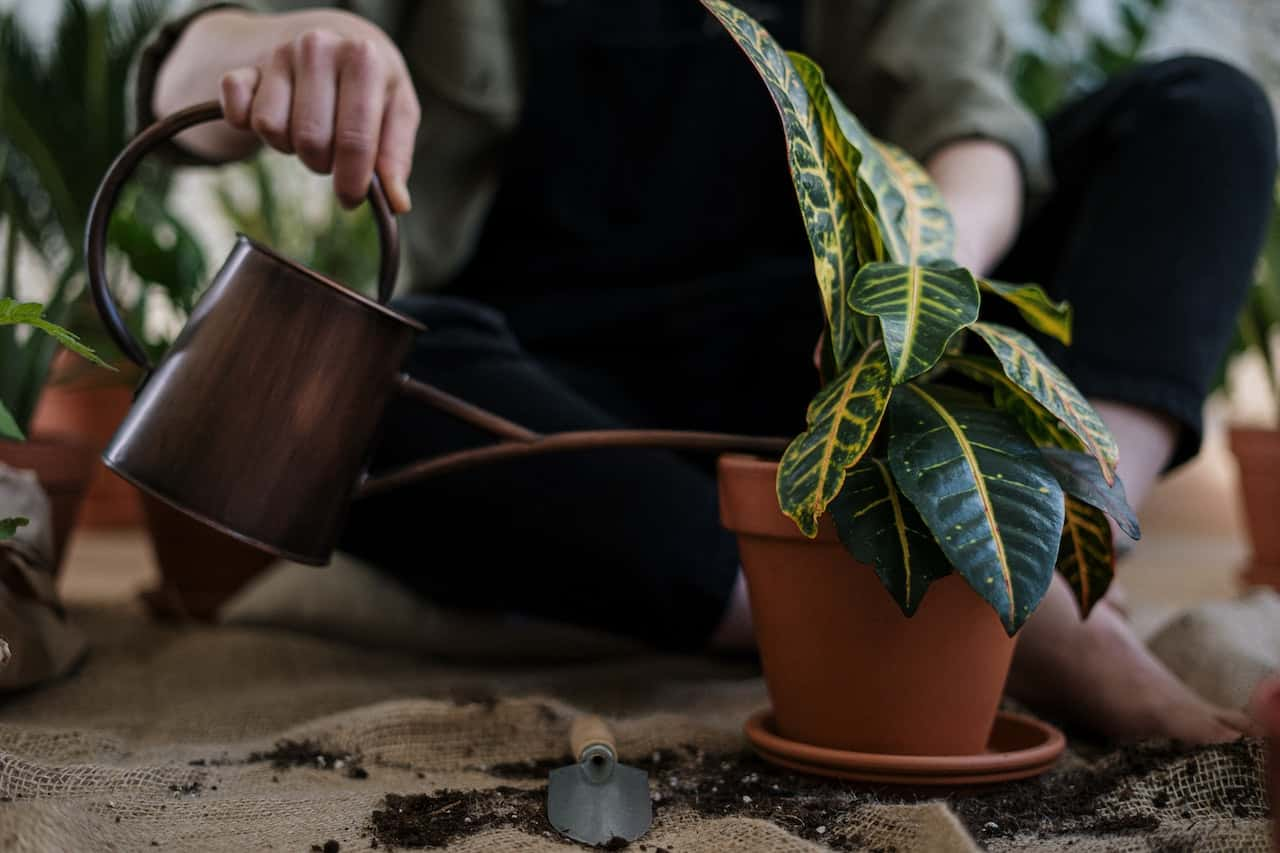 Keep the following points in mind while growing croton in your house or garden.
Keep the following points in mind while growing croton in your house or garden.
Light
Croton plants need six to eight hours of sunlight to thrive. A spot that receives indirect light throughout the day is the best. Some species cannot tolerate direct sun but require dappled sunlight. You can know the plant isn’t receiving enough light if its leaves turn green.
Soil
Crotons plants should be planted in loose, well-draining soil. Choose a sturdy pot that can anchor the plant as they grow in height. Indoors crotons are best placed beside your brightest window.
Water
Croton plants favour warm, humid environments due to their tropical origin. So keep the soil base evenly moist but not constantly wet. Check the soil regularly. If it feels dry when touched, it’s time to water them.
Also, look out for indicators of water needs, such as wilting of young foliage. The plant may require frequent misting in a dry environment for healthy foliage growth.
Temperature and Weather Conditions
Crotons are warm-weather plants. They grow best in temperatures between 70 to 80 degrees Fahrenheit, though they can tolerate temperatures as high as 100 degrees Fahrenheit and as low as forty degrees Fahrenheit. You’ll need to bring your plant indoors for areas where the nighttime temperature drops below 10 degrees Celsius.
Fertilizer
Like all plants, Crotons, too, need lots of nutrients to grow their colourful foliage. So fertilize the plants every month during growing periods in summer, spring, and early fall with water-soluble plant feed.
Since fertilizers vary from type to type, read the package instruction for feeding quantity. Depending on how vigorously you want the plant to grow, you can add or reduce the dose. Stop fertilizing during the winter months.
Pruning
You can prune croton plants from time to time to remove dead leaves and give the plant a proper shape. Periodic pruning can rejuvenate the plant. But ensure not to cut off more than 1/3rd of the stem height at a time. Instead, trim just above the node or leaf set so they can regrow from the cut portion.
Wrapping Up
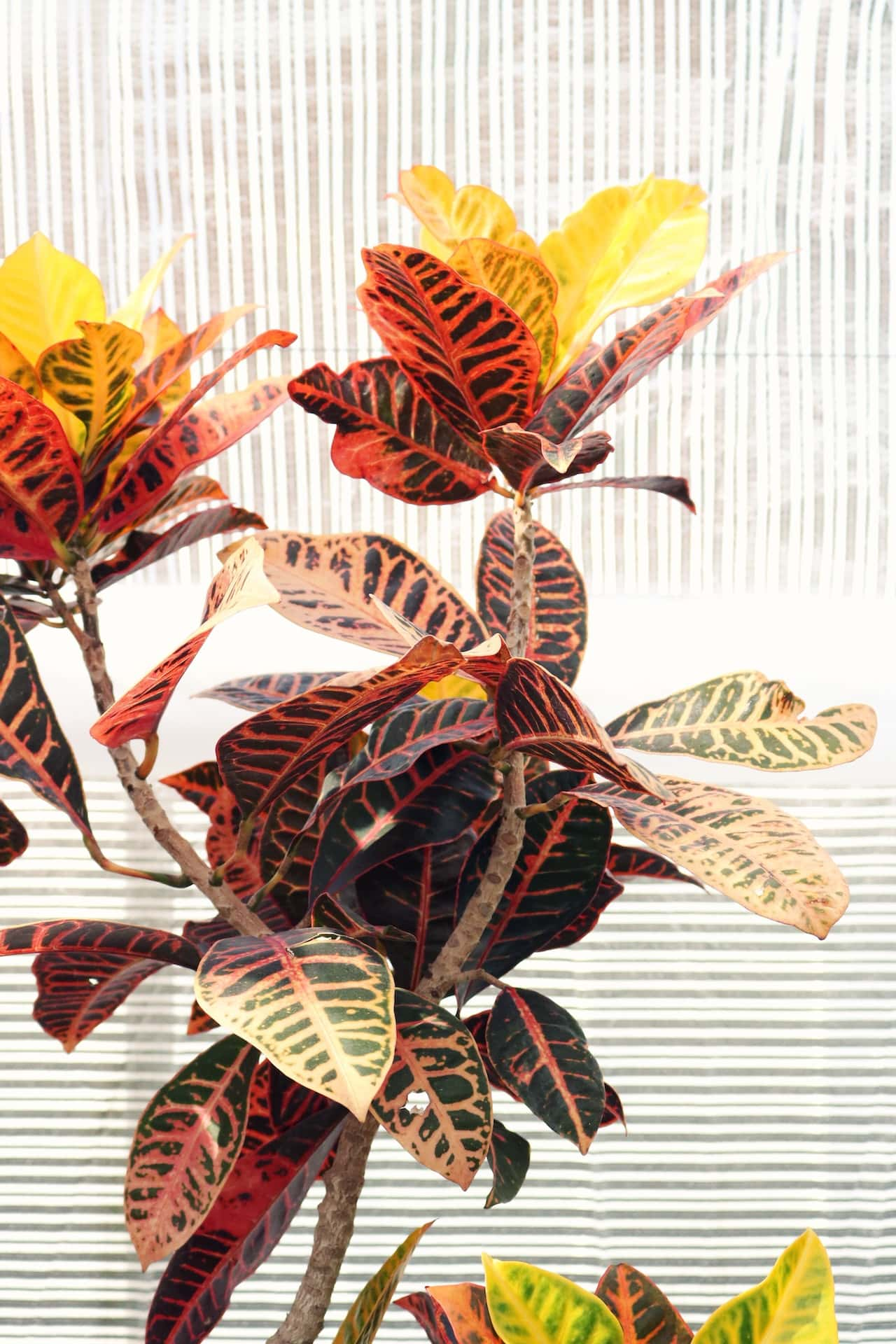 Now that you’ve learned the different types of croton plants, you can easily choose the one that best suits your interiors. Even better is having different croton varieties for each corner of your home or office. If properly looked after, they can adorn your living room for years.
Now that you’ve learned the different types of croton plants, you can easily choose the one that best suits your interiors. Even better is having different croton varieties for each corner of your home or office. If properly looked after, they can adorn your living room for years.
If you’re looking for ideas to make your interiors bright and colourful, you’ll find tons of them at homelane.com. HomeLane specializes in creating beautiful and customized interiors that stand out. If you’re interested in exploring innovative interior décor ideas, you can book an online session with HomeLane.
FAQ’s
1. How many wide varieties of croton plants are there?
There are more than 100 croton varieties worldwide. They are available in a wide assortment of leaf types and colours. Oval, elliptical, ribbon and rounded leaves are some popular leaf types. These leaves vary in colour between white, green, orange, yellow, pink, red, and purple. With age, the leaves darken to almost black.
2. Which croton plant is best?
Though often grown outdoors in tropical climates, croton plants make excellent houseplants. All varieties of plants are unique and beautiful in their way. So the best croton plant choice lies in the eye of the beholder.
Consider your interior and the size of the plant your room can accommodate before choosing between the different types of croton plants. Colourful crotons like Zanzibar, petra, bush on fire, and Picasso’s paintbrush add personality and charm to your interiors. But if you like plants with greener shades, you can go for golden dust or Andrew crotons.
Though most crotons require indirect light, some grow well in shadows. If you have dark interiors, classic Petra crotons or magnificent crotons could be excellent choices as they are resilient and do not lose colour in the shade.
3. What is the lifespan of a croton plant?
An indoor croton plant generally lives for two to four years. Outdoor plants can live much longer if the weather condition is suitable. However, you can keep the plant growing for many years by propagating them.
Propagating a croton plant is relatively easy. Take a three to four-inch stem cutting from a mature, healthy plant and plant it in a small pot. Ensure that the cutting has at least three to five leaves on it.
Place the pot in a warm area (ideally 70 to 80 degrees Fahrenheit) and water the soil to maintain continuous moisture. The plant will take root in about a month. You can then transfer it to a larger container. This way, you can keep your plant growing for years.
4. How fast do crotons grow?
Crotons are slow-growing house plants. They can grow up to 12 inches each year during the growing season. The plant takes two to three years to reach its full maturity.
Outdoor crotons have been found to reach up to twelve feet in height. However, the maximum size of indoor crotons is restricted to 4 feet. The height and growth rate also depend on the species of croton you’ve grown.
You can encourage faster growth by providing warm temperatures, bright indirect light, adequate moisture, and monthly fertilization.
5.Are crotons good houseplants?
Yes, crotons make very good houseplants. Their stunning foliage, splashed with vibrant greens, yellows, reds, and oranges, adds a pop of colour to any room!
They’re relatively easy to care for as long as you can provide bright, indirect sunlight and consistent moisture. However, keep in mind that they are tropical plants and prefer warm, humid environments. If your home is on the dry side, regular misting or a pebble tray filled with water can help increase humidity around your croton.
Croton leaves are dust magnets, so you would do well to gently wipe the leaves with a moist cloth once a week or so. Also remember that they do not tolerate cold drafts or sudden changes in temperature, so should not be kept near a drafty window.
Croton plants are usually resilient to pests, but could be susceptible to anthropod pests like mites and mealybugs. To remove them, gently wash the plants with an organic soap solution and rinse well. You can also try coating the leaves with neem oil as a preventive method.
6.Can I propagate croton plants at home?
Yes, you can very easily propagate croton plants at home!
Stem cuttings are the most common method of propagation. Take a healthy stem tip with a few leaves, remove the lower leaves, and dip the cut end in rooting hormone (this is optional, but quite helpful).
Plant the cutting in a moist, well-draining potting mix and keep it warm and humid. With patience, you should see roots develop in a few weeks. Be sure to research proper propagation techniques to increase your chances of success.
It’s also a good idea to sterilise your cutting tool by dipping it in boiling water before using it, to avoid introducing any pathogens to your new plant.
7.Are croton plants safe for pets?
Unfortunately, the answer is no, they are not safe.
While crotons are beautiful plants, it’s important to be aware that almost all parts of the croton are poisonous, if ingested. The sap can also irritate skin. So, if you have curious pets or small children, you may want to consider a different type of houseplant.
Keep crotons out of reach of your pets and little kids, and wash your hands thoroughly after handling them. If anyone you know has ingested any part of the plant or its sap, please contact the doctor at once!

